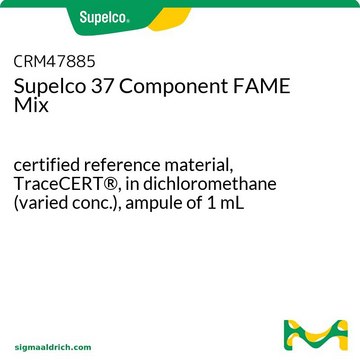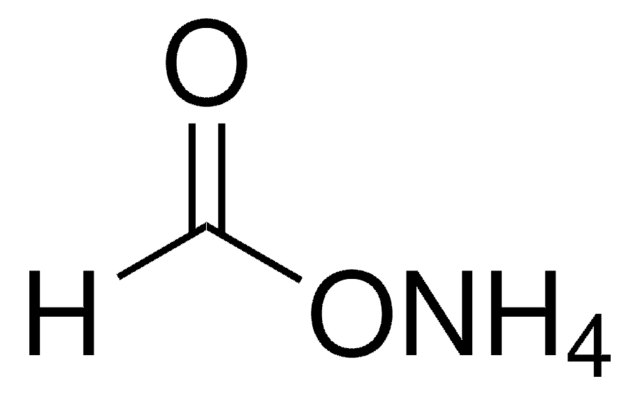Wszystkie zdjęcia(1)
Kluczowe dokumenty
23307-U
SPB®-5 Capillary GC Column
L × I.D. 50 m × 0.32 mm, df 5.00 μm
Synonim(y):
Kolumna GC, SPB-5, 5% difenyl
Zaloguj sięWyświetlanie cen organizacyjnych i kontraktowych
About This Item
Kod UNSPSC:
41115710
eCl@ss:
32119290
NACRES:
SB.54
Polecane produkty
Materiały
fused silica
Poziom jakości
agency
meets requirements for USP G27 and G36
Parametry
-60-300 °C temperature (isothermal or programmed)
Wartość beta
16
df
5.00 μm
metody
gas chromatography (GC): suitable
dł. × śr. wewn.
50 m × 0.32 mm
grupa aktywna macierzy
Bonded; poly(5% diphenyl/95% dimethyl siloxane) phase
typ kolumny
capillary non-polar
Szukasz podobnych produktów? Odwiedź Przewodnik dotyczący porównywania produktów
Powiązane kategorie
Opis ogólny
Application: This non-polar general purpose column provides primarily a boiling point elution order with a slight increase in selectivity, especially for aromatic compounds.
USP Code: This column meets USP G27 and G36 requirements.
Phase:
USP Code: This column meets USP G27 and G36 requirements.
Phase:
- Bonded
- Poly(5% diphenyl/95% dimethyl siloxane)
- ≤0.32 mm I.D., <2 μm: -60 °C to 320 °C (isothermal or programmed)
- ≤0.32 mm I.D., ≥2 μm: -60 °C to 300 °C (isothermal or programmed)
- ≥0.53 mm I.D., <2 μm: -60 °C to 300 °C (isothermal) or 320 °C (programmed)
- ≥0.53 mm I.D., ≥2 μm: -60 °C to 260 °C (isothermal) or 280 °C (programmed)
Zastosowanie
Kolumna kapilarna GC 2833-5 była odpowiednia do badania wysokich odzysków wielopierścieniowych węglowodorów aromatycznych (WWA) podczas preparatywnej kapilarnej chromatografii gazowej ze spektrometrią mas. Może być również stosowana do oznaczania herbicydów przy użyciu mikroekstrakcji do fazy stałej (SPME).
Inne uwagi
Oferujemy różnorodne akcesoria do chromatografii, w tym strzykawki analityczne.
Informacje prawne
SPB is a registered trademark of Merck KGaA, Darmstadt, Germany
Ta strona może zawierać tekst przetłumaczony maszynowo.
Wybierz jedną z najnowszych wersji:
Masz już ten produkt?
Dokumenty związane z niedawno zakupionymi produktami zostały zamieszczone w Bibliotece dokumentów.
Manolis Mandalakis et al.
Journal of chromatography. A, 996(1-2), 163-172 (2003-07-02)
Operation parameters of a preparative capillary gas chromatography (pcGC) system were optimized to facilitate clean and efficient harvesting of individual polycyclic aromatic hydrocarbons (PAHs) for subsequent compound-specific radiocarbon analysis. For PAHs, the recommended optimized settings of the specially-designed pcGC cooled
L J Krutz et al.
Journal of chromatography. A, 999(1-2), 103-121 (2003-07-30)
Liquid-liquid extraction or solid-phase extraction followed by gas chromatography (GC) or high-performance liquid chromatography are traditional herbicide residue determination methods for environmental samples. Solid-phase microextraction (SPME) is a solventless, fast, and sensitive alternative herbicide residue extraction method that can be
O Suzuki et al.
Forensic science international, 46(3), 169-180 (1990-07-01)
Positive-ion electron impact (PIEI), positive-ion chemical ionization (PICI) and negative-ion chemical ionization (NICI) mass spectra of 9 carbamate pesticides are presented. In the PIEI mode, the spectra showed small molecular peaks, intense or base peaks due to M - CH3NHCO
Luisito Cercaci et al.
Journal of chromatography. A, 985(1-2), 211-220 (2003-02-13)
The sterol composition of extra virgin olive oil is very characteristic and, thus, has become a helpful tool to detect adulterations with other vegetable oils. Special attention has been addressed to the separate determination of the free and esterified sterol
J M Jurado et al.
Talanta, 106, 14-19 (2013-04-20)
4-Methylsterols and 4,4-dimethylsterols of 47 samples of subcutaneous fat from Iberian pigs reared on two different fattening systems, "Extensive" and "Intensive", have been analyzed by GC-MS and GC-FID. The lipids were extracted by melting the subcutaneous fat in a microwave
Nasz zespół naukowców ma doświadczenie we wszystkich obszarach badań, w tym w naukach przyrodniczych, materiałoznawstwie, syntezie chemicznej, chromatografii, analityce i wielu innych dziedzinach.
Skontaktuj się z zespołem ds. pomocy technicznej






